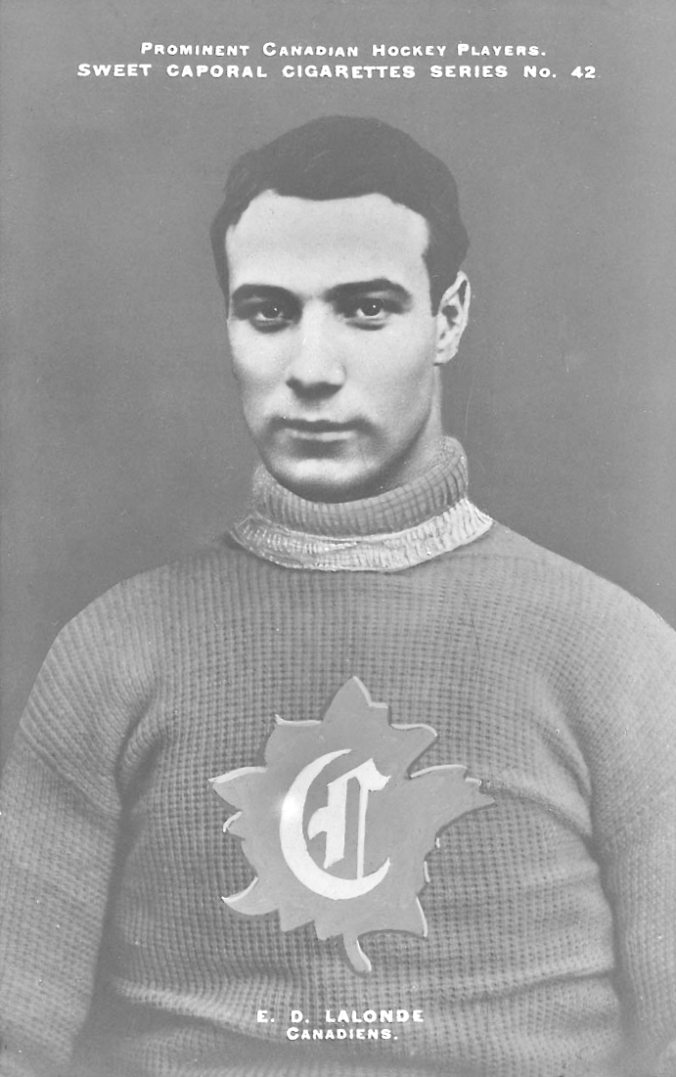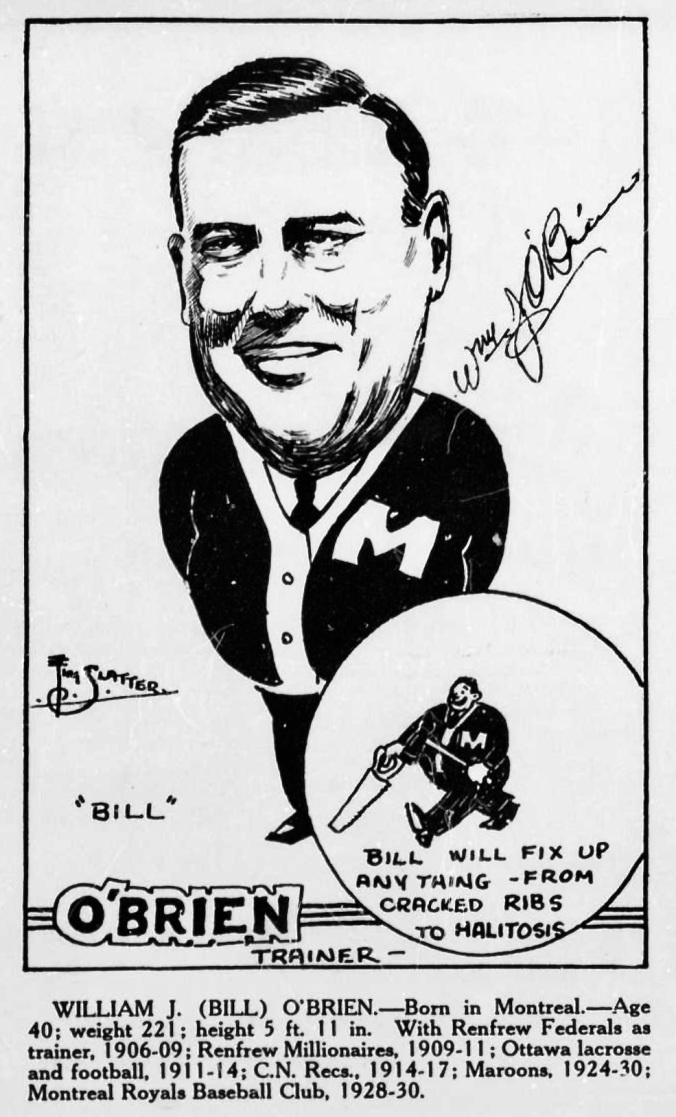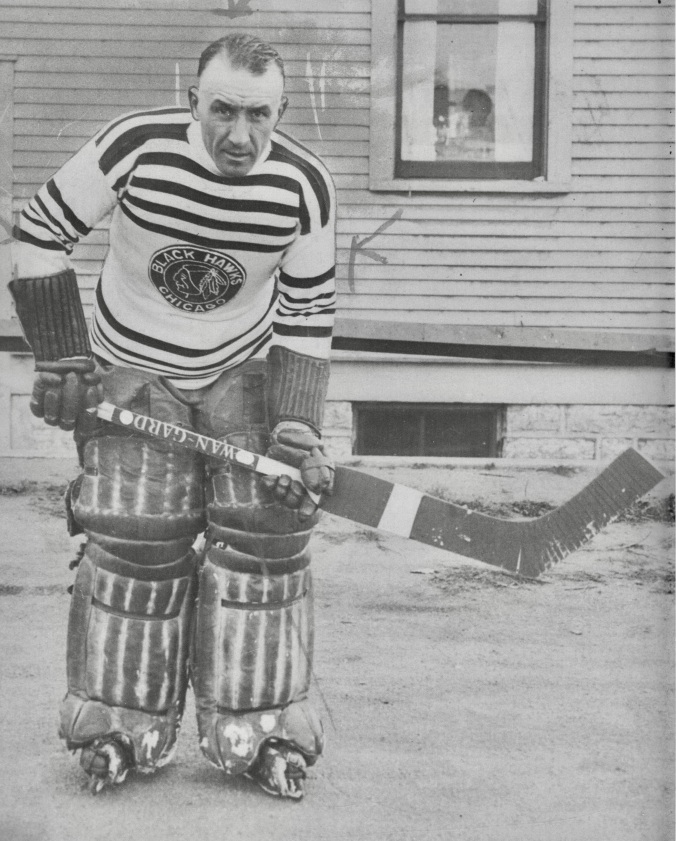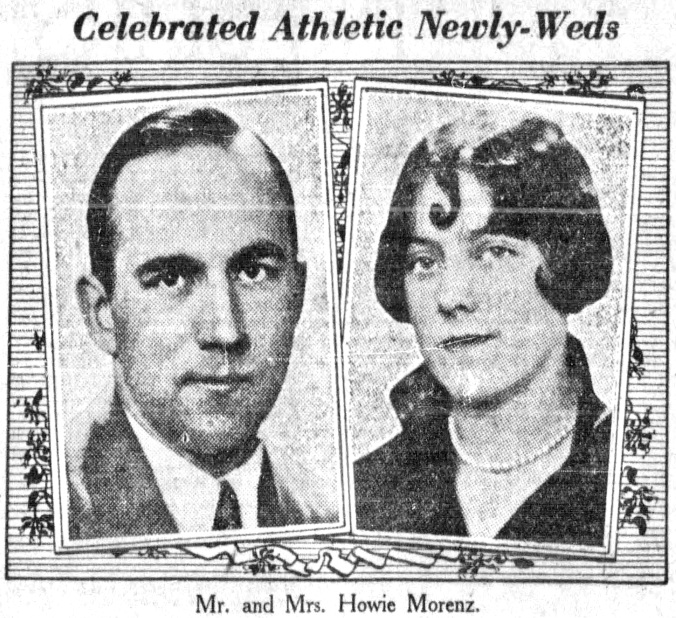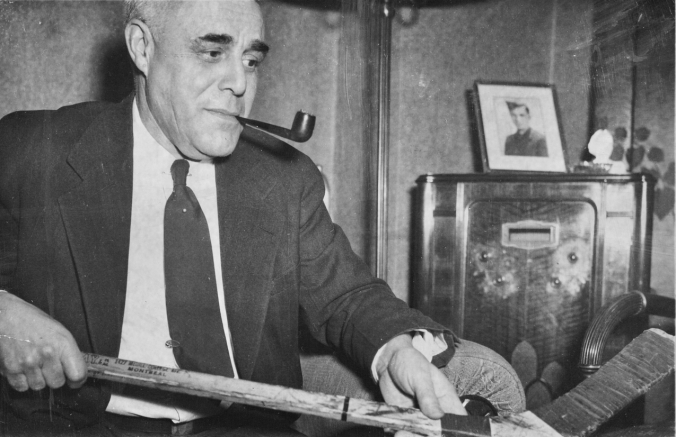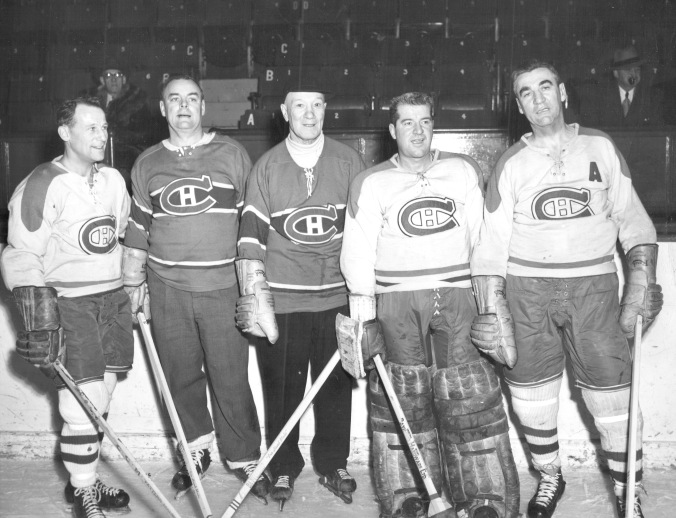
Poison Control: A 1952 magazine ad for Pleasant Moments whisky celebrated Nels Stewart’s 1931 record-setting outburst with this imaginative view of one of the two goals he scored within four seconds to lead his Montreal Maroons to a win over the Boston Bruins. (Artist: John Floherty Jr.)
By early afternoon, the signs at Montreal’s Forum were already up: Standing Room Only. “And long before the referees called the teams together at centre ice to start the game, all this space had been grabbed up,” the Gazette’s Marc McNeil would recount. “It was a complete sell-out Saturday night. And those 13,000 fortunates witnessed a mighty spectacle that crammed action and thrills into every minute of play.”
Playing a leading role that night in January of 1931: Nels Stewart, star centreman for Montreal Maroons and the reigning Hart Trophy winner as NHL MVP. In a battle between two of the NHL’s best teams, Stewart, who was born in Montreal on a Monday of yesterday’s date in 1902, powered his team to a win over the visiting Boston Bruins with a third-period outburst, setting a record for speedy scoring that stands to this day.
That being the case, today’s another day that I’ll be pleased to gripe that Stewart doesn’t get the recognition he deserves. His absence from the NHL’s 2017 list of the 100 Greatest Players in league history tells you everything you need to know about that marred memorial. Stewart won a Stanley Cup with the Maroons in 1926 and was the first man to win the Hart Trophy twice. Along with his seven seasons in Montreal, Stewart played another five for the New York Americans along with four for Boston where, though the Bruins themselves have forgotten it, he captained the team. In 1937, the man they called Old Poison overtook Howie Morenz as the NHL’s all-time leading goalscorer, a height he held until Maurice Richard overtook him in 1952. Stewart was elected to the Hall of Fame in 1962.
Toronto Telegram columnist Ted Reeve grew up with Stewart in the Beaches, in Toronto’s eastern end. “The best natural all-round athlete I have ever seen in Canada,” Reeve called him.
“Extremely deceptive,” was Frank J. Selke’s verdict, “the brainiest player I have ever known.”
Selke also testified that Stewart “couldn’t backcheck a lick.”
“He is worthless as a defensive player, always has been,” Herb Manning wrote in the Winnipeg Tribune in 1939. “There is nothing streamlined about him. He lumbers along like a truck on a steep grade. He always seems to be ten feet behind the play, whether they are going backward or forward.”
But?
“But a split second is all the time he requires to complete a chore in the enemy zone.”
He got his chores done, scoring 324 goals in 650 regular-season NHL games, nine more in 50 playoff games.
In Montreal, he centred the famous S line, flanked by Hooley Smith and Babe Siebert. “Babe and Hooley did most of the work,” Stewart later said, “because I was a shambling six-footer who took relays from the corners.”
In 1938, the Ottawa Journal wrote about his “careless, almost lazy style,” noting also that “no goalie ever feels at ease while he is lurching and wandering around the vicinity of the net.”
Ottawa Senators goaltender Clint Benedict: “Nels liked to park and take a puck and fire it quick.”
“Nels was one helluva hockey player,” New York Rangers centreman Frank Boucher said. “He was almost impossible to move once he got in front of the net.”
Harold Burr of the Brooklyn Daily Eagle consulted former Senators star defenceman Eddie Gerard on Stewart’s virtues in 1932, when Gerard was coaching the New York Americans.
“Big and wide of beam,” was Burr’s description of Stewart, whose playing-days metrics came in at 6’1’’, 200 pounds.
No other player in the National Hockey League practices his loafing around the nets of the enemy. He doesn’t look dangerous. He isn’t a fast skater or a hard shot. But he does all his playing from the other fellow’s blue line.
“Watch him lift his shoulder to draw the goalie out,” warns Gerard, his old Montreal boss. “That’s why he scores so frequently — he makes the goalminder make the first move. But watch further. Nels never shoots from the shoulder. He just flips his wrist.”
Boston bought him in 1932. “He is a two-fisted fighting player,” coach Art Ross said at the time, “and the greatest inside player in the game.”

Greatest Inside Player in the Game: Montreal Maroons’ star Nels Stewart as he actually looked in the early 1930s.
Which brings us back to that night at the Montreal Forum in 1931, Saturday, January 3. Nearly halfway through the season’s schedule, the visiting Bruins were heading up the league’s American section, while the Maroons were atop on the Canadian side, neck-and-neck with the Canadiens, defending Cup champions.
Maroons prevailed, 5-3, despite going into the third period trailing 3-1. D.A.L. MacDonald wrote up the game for the Montreal Gazette, and he speculated that if the frenzied Montreal fans had any regrets, they might have centred on the hurry with which the home team turned the game around.
First winger Jimmy Ward scored. Six minutes later, Stewart stepped up after Hooley Smith slammed a shot into Tiny Thompson’s pads. “The rebound dropped barely a foot in front of the Boston goalie and big Nelson Stewart was in like a flash to flip the puck over his prostrate form,” was how MacDonald saw it. “If Nels had scooped it up with a dessert spoon he couldn’t have done it more neatly.”
That tied the game. Four seconds later, Stewart scored the winner. It went like this:
From the face-off once again, Stewart slipped a pass over to Smith that left the Boston front rank behind and at the defence back came the disc to Nelson. The big fellow rode right in on Thompson and the goalie never had a chance. Another flip of those steel wrists and Maroons were in front to stay.
Two goals in four seconds. “Shades of Frank McGee!” MacDonald enthused. “For quick scoring feats and high-powered excitement, Nelson the Great has few equals.” It would, indeed, take 64 years for another NHLer to match Stewart’s record. No, not Gretzky or Lemieux: in1995, Winnipeg Jets defenceman Deron Quint scored a pair of goals in four seconds versus the Edmonton Oilers to slip into the record book alongside Stewart.
Is there any indication that in scoring his brisk brace, Stewart might have distracted or disabled Tiny Thompson by spitting tobacco juice into his unsuspecting eye?
No, none. Though that is a stratagem that is persistently attributed to Stewart in latter-day accounts of his career. Mostly it’s offered up as passing proof of his cunning and/or outright nastiness, often with a hint of admiration — if not any specificity.
The general tobacco-spitting charge shows up in Stewart’s Wikipedia profile, for instance. Floyd Conner slots it into Hockey’s Most Wanted (2002), with his own twist: the eye-spitting was motivated by Stewart’s “contempt” for goaltenders. In his 2012 book, Next Goal Wins, Liam Maguire goes out on a limb of his own to venture that the nickname Old Poison derived directly from “his habit of spitting chewing tobacco into the eyes of opposing goaltenders.”
Stan Fischler has been one of the more enthusiastic purveyors of the expectorating story over the years; it repeats throughout his broad oeuvre. Here it is in his The All-New Hockey’s 100 (1998):
It was not uncommon for Stewart to chew a wad of tobacco, produce juice, and then spit it unerringly in the eyes of a goalie as he shot the puck.
None of the above mentions is sourced; not one identifies a particular instance which any first-hand accounting to back up the chewing/juicing/spitting combo that Stewart is reputed to have employed to such (purported) devilish effect. None of the authors cited above seems to have done any digging of their own. If they had, they’d have found that no-one seems to have been taking note of Stewart’s spitful habit when he was actually playing: my scourings of contemporary newspaper accounts from Stewart’s active years in the 1920s and ’30s haven’t turned up even a fleeting mention of any tobacco-chewing let alone spitting.
The legend does (fittingly?) crop up in the five-part hockey-history TV series that Vancouver’s Opus Pictures produced in 1996, Legends of Hockey, and my guess (it’s mostly a guess) is that it’s from this (also unsourced) documentary that the subsequent literary mentions originated and proliferated. (Wikipedia’s mention of Stewart’s adventures in chaw footnotes it.) The second episode includes short biographies of several colourful hockeyists, including Eddie Shore, Red Horner, and Ol’ Poison himself. You can click in to review it here, starting at the 27:26-minute mark, where you’ll soon hear narrator Alan Maitland intone:
As well as being poison around the net, the Montreal Maroons’ Nels Stewart had the nasty habit of spitting his chewing tobacco in the goalie’s eyes. Never a great skater, never a great checker, he was still a lethal goalscorer.
As Garth Woolsey of the Toronto Star wrote back in 1996, Legends of Hockey is, as a whole, a delightful confection. Specifically citing Stewart and his alleged spitting, Woolsey also notes that “in the off-hand fashion of such productions, this pungent detail is presented without elaboration. Legends delivers with more similar tidbits of history, whetting the appetite. What it might not explain meatily, the series suggests delectably.”
Is it possible that there’s truth at the root of the legend, wherever that might lie? Of course. But without any first-hand account of where Stewart might have been chewing his tobacco and loosing it on contemptible goaltenders, or when, or who the goaltenders might have been, I’ll be wary of treating the tale as fact. I don’t mind James Marsh’s formulation in his biography of Stewart in The Canadian Encyclopedia:
The story that he spat tobacco juice in the eyes of opposing goalies may be apocryphal but apparently is in keeping with his temperament on the ice.
If Newsy Lalonde merits a mention here (and he does), it’s because he’s a, well, key witness in the larger case — as well as a prime suspect.
Lalonde, of course, was one of hockey’s greatest talents, as well as another fairly glaring absentee from that centenary list from 2017. His pro career on ice started as early as 1906, and he went on to play seven NHL seasons, mostly with the Montreal Canadiens, before it was over in the late 1920s. He was famously uncompromising — which is one generous way of saying that he played the game violently and often with what still looks like, over the distance of years, breathtaking spite.
Not that he was (apparently) alone in his willingness to twist rules or (as the case may be) soak them in tobacco juice in those early decades. Long after he’d hung up his skates he was still recalling the transgressions of opponents like Paddy Moran, Stanley-Cup-winning goaltender for the Quebec Bulldogs and a fellow Hall-of-Famer. Here’s Lalonde reminiscing in 1951, as reported in the Montreal Gazette:
“Paddy chewed tobacco,” Newsy said, “and he could hit a keyhole at 40 paces. You had to duck when you skated behind his cage or he’d get you right between the eyes.”
Lalonde elaborated on this theme a decade later. This time he was talking to Andy O’Brien for a feature on hockey malice for Weekend Magazine.
“Paddy [Lalonde said] was in a class by himself by himself when it came to chopping toes of opposing forwards who came within range, and in those days the skate toes weren’t so well padded. But his pet skill was squirting tobacco in your eye.”

In 1961, Newsy Lalonde implicated Paddy Moran for his chaw crimes.
What would it have cost Any O’Brien to press for just a few more details? As it is, I guess Lalonde’s long-range memories do get us closer to a confirmed case of tobacco-juice-in-the-eye without pinpointing anything precisely. The best we might be able to hope for on that count focusses again on Newsy Lalonde, though he’s not (and probably shouldn’t be expected to be) implicating himself this time. It’s another goaltender of old giving evidence here, Jakie Forbes, who was playing for the Toronto St. Patricks in the early 1920s when Lalonde was skating for — and captaining and coaching — the Canadiens.
Forbes’ news wasn’t exactly fresh when he got around to reporting it: one version I’m looking at dates to 1969, 50 years after the fact, when Forbes was 72, and the other is from Trent Frayne’s 1974 book The Mad Men of Hockey.
Both accounts are, it has to be said, fairly vivid, even if they don’t perfectly match up.
The first, from a genial Globe and Mail retrospective, has Forbes telling his tale this way to writer James Young:
The game is much faster now, but not nearly as rough as it was. In one game at the old Mount Royal rink in Montreal, Newsy Lalonde came around the net and caught me in the eye with his stick. I went skating out to protest to the referee and skated right into him, knocking both of us down. He said he had not seen the incident and sent me back to the net.
The next time Lalonde came down to my end of the ice I went out to stop him, using a high stick if possible. He skated to the side of me, spit his tobacco juice in my face and when I fell skated around me to score in the open net.
Trent Frayne’s framing of this same tale five years later isn’t quite the same; it does up the colour balance.
“He was,” Forbes says this time, by way of introducing Lalonde, “the dirtiest son of a bitch I ever played against.”
In Frayne’s version, Forbes stopped Lalonde and the puck was headed back the other way. As Lalonde rounded the net to follow it, he paused to punch Forbes squarely — and hard — in the face.
“Blood spurted from the goaler’s nose,” Frayne writes, “and he took off after Lalonde, brandishing his stick like a lariat.”
The referee is named as Cooper Smeaton, and he does get knocked down. Jumping up, he’s quoted threatening Forbes:
“Get back in the goal, you crazy little bugger,” he shouted at the five-foot-five goaltender, “or you’re out of the game.”
Frayne adds some fine points to the final act of the piece, too. Near the end of the game, with Canadiens leading 4-1, Lalonde broke in with the puck. Forbes was ready for him, “readying an axe-swing at Lalonde’s head.”
But at the last instant the flying Lalonde spat a long stream of tobacco juice into Jakie’s face, circled the net laughing, and pushed the puck into the goal past the sputtering Forbes.
Triangulating with a few of the details provided by Frayne, it’s possible to key in a couple of games from the two seasons Forbes spent with Toronto. The first time he played Canadiens in Montreal was on Wednesday, March 10, 1920, a night on which the local Gazette found plenty in his performance to praise: “Forbes the Youngest Goaler in NHL Made Many Brilliant Stops at Mount Royal Arena,” reads a subhead from the next morning’s dispatch.
Too bad for Forbes, Montreal won, 7-2, with Lalonde scoring a hat trick. But contemporary accounts mention no high sticks, punches, or other hijinks. Also, the referee that night was Harry Hyland. So that’s probably not the night in question.
A better bet altogether is a game from almost a year later, a Monday-nighter played on February 28, 1921. It was noteworthy affair on several counts. A former U.S. president was one of the 5,000 spectators on hand, for one thing: what’s more, William Howard Taft was “in position to have a good view” of a first-period fight between Toronto’s Ken Randall and Didier Pitre of Montreal.
It was a thoroughly bad-tempered occasion even before the teams hit the ice. Toronto was lending winger Cully Wilson to Canadiens that season, but just before the game, with centreman Corb Denneny ill and unable to play, the St. Pats tried to claim Wilson back for their own line-up.
NHL President Frank Calder was in the building and presided over a summit in the referee’s room. The Montreal Star mapped the terrain:
If he played with Canadiens, Toronto would protest him. If he played with Torontos, Canadiens would no doubt protest him, and if he refused to play with Torontos, whose property he was, he would be suspended. The president, however, refused to counsel him what to do, and told him to suit himself, bearing in mind that he was Toronto’s property.
Wilson sat out and, indeed, never suited up for either Montreal or Toronto again: the following season he turned out for the Hamilton Tigers.
In Montreal in 1921, the game went sourly on without him. “There were many unparliamentary clashes,” the Star reported. The Mount Royal Arena’s natural ice deteriorated as the game continued, too. In the second interval, the Star’s reporter watched as “the men who were supposed to scoop the snow off the ice only got water for their pains, and when the third period began, the ice was like mud. When a man fell he got up sopping wet.”
It was in the second period that Forbes and Lalonde first sparred, though whether it was a high stick or a punch that the latter perpetrated isn’t clear. Press reports make no mention, either, of a collision between Forbes and Smeaton. “Lalonde was given a minor for charging Forbes,” is as much as we get from the Gazette, though with an interesting coda: “Lalonde was booed for his attack on the net custodian.” (Le Droit: “Lalonde was hissed when he jostled Forbes.”)
In Trent Frayne’s telling, the game ended 5-1 for Montreal, which wasn’t the case on this night. Lalonde did score Canadiens’ final goal, towards the end of the third, to complete a 4-0 Montreal win (and Georges Vézina shutout). As the Star had it, “Lalonde’s brilliant lone-handed shot finished the scoring.”
But if reporters present saw Lalonde score, none of them would seem to have noticed him spit his tobacco or laugh, and nor did they catch Forbes’ sputtering as he failed to foil him. That doesn’t mean that a spit-assisted goal isn’t part of hockey history which remains, after all, mostly a matter of the many moments, savoury or not, that go unrecorded.

Famous Five: Lined up from left, Newsy Lalonde, Lester Patrick, Odie Cleghorn, Frank Calder, and Cooper Smeaton, circa the … early 1930s? (Image: La Presse)

